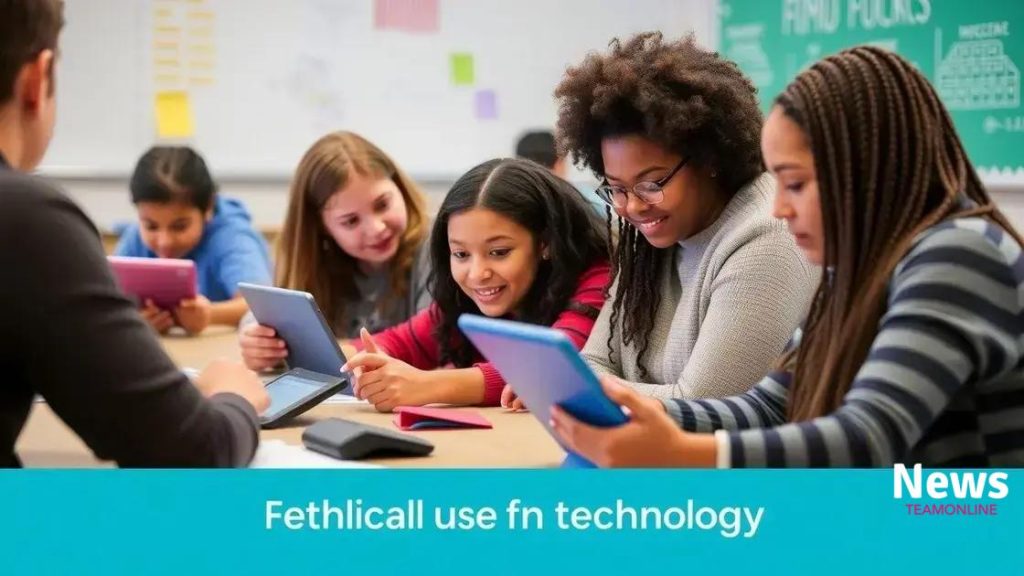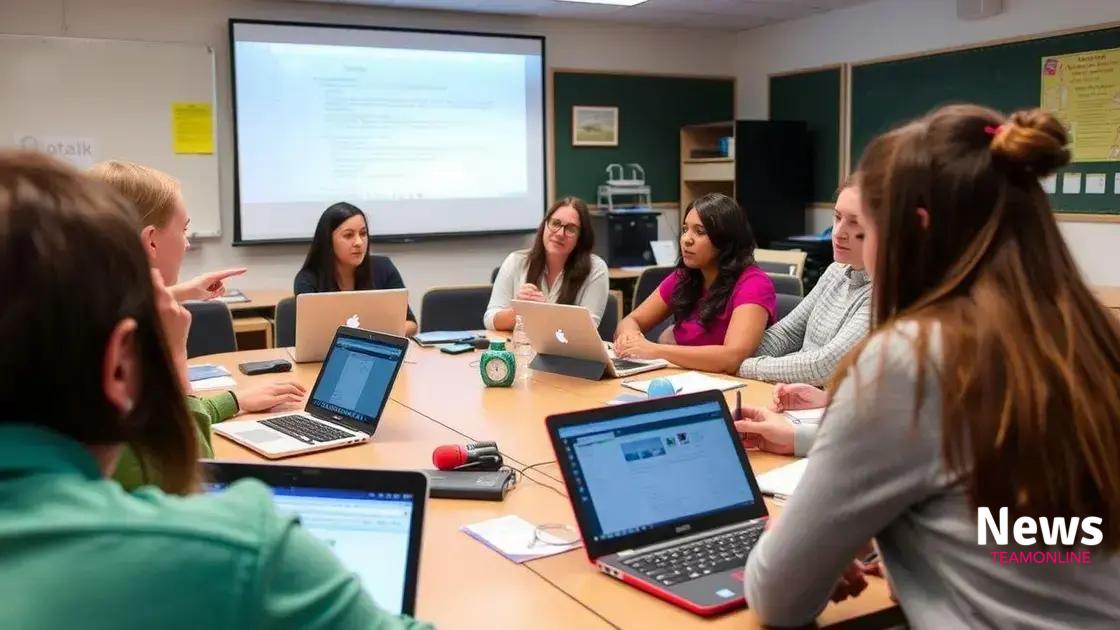Ethical use of EdTech tools in schools: a guide

The ethical use of EdTech tools in schools involves protecting student privacy, ensuring equitable access, selecting the right tools, and fostering digital citizenship while maintaining transparency and integrity in educational practices.
In today’s educational landscape, the ethical use of EdTech tools in schools has never been more important. With the rapid integration of technology in classrooms, understanding how to navigate these tools responsibly can make a significant difference in student engagement and learning outcomes. Let’s explore how we can use EdTech in a way that benefits all.
Understanding the importance of ethics in EdTech
Understanding the importance of ethics in EdTech is essential for creating a safe and effective learning environment. As technology rapidly evolves, educators must consider how to use these tools responsibly.
Why Ethics Matter in Education Technology
The ethical use of technology ensures that all students are treated fairly and have access to the resources they need to succeed. It promotes trust between students and educators while safeguarding sensitive information.
Key Ethical Principles
When integrating EdTech into the classroom, several guiding principles can help educators navigate ethical dilemmas:
- Transparency: Clearly communicate how and why technology is being used.
- Privacy: Protect student data and ensure that personal information is secure.
- Equity: Provide equal access to technology resources for all students.
- Inclusivity: Consider diverse learning needs when choosing educational tools.
By adhering to these principles, educators can foster an environment where students feel safe and encouraged to engage with technology.
Moreover, ethical considerations extend beyond initial implementation. Ongoing assessment of technology use in the classroom is vital. Regularly reviewing the impact of these tools allows educators to adjust and improve practices, ensuring that they align with ethical guidelines.
Ultimately, understanding the importance of ethics in EdTech not only enhances the educational experience but also prepares students for a future where technology will play a pivotal role in their lives. It is an ongoing responsibility that requires dedication, awareness, and a proactive approach.
Key ethical considerations for educators
Key ethical considerations for educators using technology are vital in shaping the classroom experience. When integrating EdTech, it is important to remain aware of the impact technology can have on students’ learning. Educators must strive to create an environment that not only promotes engagement but also safeguards students’ rights.
Protecting Student Privacy
One of the foremost ethical concerns is student privacy. Educators must ensure that any tools used do not compromise personal information. This includes understanding the data collection processes of various software and ensuring that consent is obtained where necessary.
Maintaining Fairness and Equity
Equity in access to technology is crucial. Not all students have the same access to devices or the internet, which can create disparities in learning. Educators should seek to provide equal opportunities by offering alternative resources or support for those in need, ensuring everyone can benefit from EdTech.
- Identifying at-risk students: Recognize students who may lack access and provide necessary resources.
- Offering support: Utilize school resources to help students acquire technology if needed.
- Creating inclusive learning environments: Design assignments that do not rely solely on technology to accommodate everyone.
Furthermore, educators must be mindful of the content shared within educational technology. The quality of digital resources is a key component. It is essential to vet tools and materials, ensuring they meet educational standards and are inclusive of diverse perspectives.
Ahigh level of integrity should be maintained when selecting resources. This ensures that students are receiving accurate and respectful information while avoiding materials that could perpetuate stereotypes or misinformation. Developers of educational tools should also be held accountable for their products, ensuring ethical standards in their design and implementation.
Recognizing and addressing these ethical considerations will help educators facilitate a positive learning atmosphere. By prioritizing privacy, equity, quality, and integrity, educators will foster trust and enhance the educational experience for every student.
Best practices for implementing EdTech ethically

Best practices for implementing EdTech ethically can help educators create a positive and productive learning environment. By following established guidelines, teachers can use technology effectively while prioritizing the well-being of their students. Start by ensuring that any technology chosen aligns with the educational goals of the institution.
Choosing the Right Tools
The selection of educational technology is crucial. Research various options to find tools that enhance learning without compromising ethics. Check for user reviews and consult with peers to make informed decisions.
- Assess compatibility: Ensure technology integrates well with existing systems.
- Evaluate educational value: Choose tools that directly support learning objectives.
- Investigate data policies: Understand how user data will be managed by the providers.
Another important practice is to educate students about digital citizenship. Teaching them the responsibilities that come with using technology is essential for their growth. Incorporating lessons on online safety, privacy, and respectful communication can empower students to make wise decisions when engaging with EdTech.
Ongoing Training and Support
Providing ongoing training for educators is vital. Regular workshops can keep teachers updated on the latest ethical guidelines and technology tools. Peer collaboration can also enhance this learning process. By sharing experiences, educators can learn what works and what doesn’t in an ethical context.
Encouraging an open dialogue about ethical challenges related to technology can create a supportive culture. Providing avenues for teachers to express their concerns can lead to better practices and increased awareness of ethical considerations.
Regularly reviewing and assessing the implementation of EdTech tools ensures that they remain effective and ethical. Gather feedback from students and staff to make necessary adjustments continuously. By prioritizing ethics in EdTech, educators contribute to a more equitable learning environment.
Potential pitfalls and how to avoid them
In the realm of educational technology, understanding the potential pitfalls is essential for effective implementation. There are numerous challenges that educators may face when integrating EdTech tools in classrooms. Awareness of these issues can lead to better decision-making and improved outcomes for students.
Common Pitfalls
One major challenge is the risk of over-reliance on technology. While EdTech can enhance learning, it should not replace traditional teaching methods. Educators must strike a balance between digital tools and personal interactions to maintain student engagement.
Neglecting Privacy Concerns
Another pitfall involves ignoring privacy concerns. Many educational tools collect data from students, which can lead to ethical dilemmas if not managed properly. Teachers should familiarize themselves with the data privacy policies of the tools they choose and ensure that sensitive information is protected.
- Review data policies: Understand what data is collected and how it is used.
- Obtain consent: Make sure to get proper consent from students and parents.
- Monitor data security: Ensure that any software used complies with data protection laws.
Technical issues can also arise, disrupting the learning process. To minimize these disruptions, schools should offer regular training and support. Providing reliable tech support can help educators troubleshoot problems quickly, ensuring a smoother educational experience.
Additionally, focusing on equitable access to technology is crucial. Not every student has access to devices or reliable internet at home. Educators should identify these gaps and work to provide resources to ensure all students can participate meaningfully in their educational experiences.
By recognizing these potential pitfalls and proactively addressing them, educators can create a positive environment that thrives on the ethical use of educational technology. Taking steps to mitigate these risks not only enhances the learning experience but also fosters trust among students and parents.
Case studies of successful ethical EdTech usage
Case studies of successful ethical EdTech usage highlight the positive impact technology can have on learning while maintaining ethical standards. These examples serve as valuable lessons for educators seeking to navigate the complex landscape of educational technology.
Example 1: Digital Citizenship Program
One school district implemented a Digital Citizenship Program to teach students about responsible online behavior. This program focused on key topics such as privacy, cybersecurity, and respectful communication. After its introduction, the district saw improved student awareness regarding online safety and a significant decrease in cyberbullying incidents.
Example 2: Blended Learning Models
Another successful case involved a high school that adopted a blended learning model. This approach combined traditional face-to-face instruction with online coursework. By carefully selecting quality EdTech tools, educators ensured that all content aligned with learning objectives and ethical guidelines. The result was a more engaged student body and improved overall academic performance.
- Increased student engagement: Students found the mixture of technology and traditional teaching methods to be more stimulating.
- Personalized learning: Educators could tailor lessons to meet individual student needs and learning styles.
- Access to resources: Students were able to explore a wider range of materials and perspectives.
Additionally, a community college launched a new initiative that focused on removing barriers to technology access. They provided laptops and internet access to underprivileged students. As a result, enrollment from low-income families increased by 25%. This initiative underscored the importance of equity in EdTech implementation.
These case studies demonstrate that ethical practices in EdTech can lead to successful outcomes. By prioritizing the needs of students, respecting their privacy, and creating inclusive environments, educators can harness the full potential of technology in the classroom.
FAQ – Frequently Asked Questions about Ethical Use of EdTech in Schools
What are the key ethical considerations when using EdTech?
Key considerations include protecting student privacy, ensuring equitable access, and maintaining transparency in how technology is used.
How can I effectively choose the right EdTech tools?
Research tools that align with your educational goals, assess their user data policies, and get feedback from peers about their effectiveness.
What are some common pitfalls in EdTech implementation?
Common pitfalls include over-reliance on technology, neglecting privacy concerns, and failing to provide adequate training for educators.
How can I foster digital citizenship among students?
Incorporate lessons about online safety, responsible communication, and respectful behavior in digital environments to promote digital citizenship.





